Amateur holography - silver halide materials
- Tutorial
The first part is about holography in general and photopolymer materials.
In a previous article, we talked about holography in general and a set for the first steps from Litiholo based on photopolymer holographic materials. Now it’s the turn to deal with silver halide photo materialsthat have significantly higher sensitivity (which means there are fewer problems with the main enemy of holography - vibration). They are common among both amateurs and professionals, they can be made independently, their main drawback is the need for chemical treatment, but this is not so difficult, which will be shown later in the text.
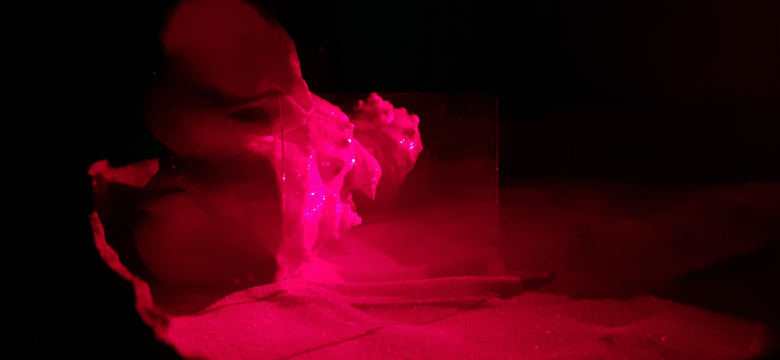
At present, both abroad and in the territory of the former USSR, halogen-silver holographic photographic materials from two manufacturers are mainly used: the Russian JSC Slavich and the French Ultimate Holography. Both organizations produce the whole range of photographic materials and chemical reagents for their processing, the most interesting for amateurs (at the initial stage, until copying schemes and color holography are mastered) monochrome photographic materials on glass suitable for Denisyuk's scheme with continuous laser radiation, this is PFG-03M Slavich and U08M at Ultimate Holography. The former have a much lower price, are well studied, and the compositions of optimal mixtures for chemical treatment are known for them. The second have the best declared characteristics, sensitization to different wavelengths to choose from, the programmed color shift of the image to a shorter wavelength region is stored much longer (6-9 months for PFG-03M and more than 5 years for U08M are declared), but processing in branded developers and bleaches is recommended for them, the composition of which is not advertised. About domestic PFG-03M, the discussion will go further.
PFG-03M are high-resolution holographic plates designed for recording reflective holograms, and they are also well suited for transmission holograms. They are a 7 μm thick gelatin layer containing silver halide crystals, a sensitizing dye and other additives on 2.65 mm thick optical glass. The claimed diffraction efficiency of at least 40%, a resolution of at least 5000 lines / mm, a holographic sensitivity at 633nm of at least 2 mJ / cm 2, maximum spectral sensitization 635nm. They have a guaranteed shelf life of 6-9 months. After the expiration of the storage period, they can also be used, but over time they increase their sensitivity, noise level, darkening after manifestation in unexposed places, and the veil formation process begins (starts along the edges and moves with time to the center).
By the way, only silver halide photographic materials are suitable for pulse shooting due to the same high sensitivity. So the holographic sensitivity of PFG-03M for a continuous 633nm laser is estimated to be no more than 2 mJ / cm 2 (in practice, it often turns out to be even 0.5 mJ / cm 2 ), for U08M 0.09-0.12 mJ / cm 2 is declared, for materials optimized for pulsed shooting, the sensitivity is even higher. But the sensitivity of the plates from Litiholo is declared as 20 mJ / cm 2 for 635 nm, while the dichromated gelatin is practically not sensitive to the red region of the spectrum, and the rather complex composition of MBDCG requires about 50 mJ / cm 2 .
It was decided not to use what is included in the kit from Litiholo, but to make everything from scratch, with a new laser and good vibration resistance.
So, the stages of manufacturing a silver halide hologram:
In a previous article, we talked about holography in general and a set for the first steps from Litiholo based on photopolymer holographic materials. Now it’s the turn to deal with silver halide photo materialsthat have significantly higher sensitivity (which means there are fewer problems with the main enemy of holography - vibration). They are common among both amateurs and professionals, they can be made independently, their main drawback is the need for chemical treatment, but this is not so difficult, which will be shown later in the text.

At present, both abroad and in the territory of the former USSR, halogen-silver holographic photographic materials from two manufacturers are mainly used: the Russian JSC Slavich and the French Ultimate Holography. Both organizations produce the whole range of photographic materials and chemical reagents for their processing, the most interesting for amateurs (at the initial stage, until copying schemes and color holography are mastered) monochrome photographic materials on glass suitable for Denisyuk's scheme with continuous laser radiation, this is PFG-03M Slavich and U08M at Ultimate Holography. The former have a much lower price, are well studied, and the compositions of optimal mixtures for chemical treatment are known for them. The second have the best declared characteristics, sensitization to different wavelengths to choose from, the programmed color shift of the image to a shorter wavelength region is stored much longer (6-9 months for PFG-03M and more than 5 years for U08M are declared), but processing in branded developers and bleaches is recommended for them, the composition of which is not advertised. About domestic PFG-03M, the discussion will go further.
PFG-03M are high-resolution holographic plates designed for recording reflective holograms, and they are also well suited for transmission holograms. They are a 7 μm thick gelatin layer containing silver halide crystals, a sensitizing dye and other additives on 2.65 mm thick optical glass. The claimed diffraction efficiency of at least 40%, a resolution of at least 5000 lines / mm, a holographic sensitivity at 633nm of at least 2 mJ / cm 2, maximum spectral sensitization 635nm. They have a guaranteed shelf life of 6-9 months. After the expiration of the storage period, they can also be used, but over time they increase their sensitivity, noise level, darkening after manifestation in unexposed places, and the veil formation process begins (starts along the edges and moves with time to the center).
By the way, only silver halide photographic materials are suitable for pulse shooting due to the same high sensitivity. So the holographic sensitivity of PFG-03M for a continuous 633nm laser is estimated to be no more than 2 mJ / cm 2 (in practice, it often turns out to be even 0.5 mJ / cm 2 ), for U08M 0.09-0.12 mJ / cm 2 is declared, for materials optimized for pulsed shooting, the sensitivity is even higher. But the sensitivity of the plates from Litiholo is declared as 20 mJ / cm 2 for 635 nm, while the dichromated gelatin is practically not sensitive to the red region of the spectrum, and the rather complex composition of MBDCG requires about 50 mJ / cm 2 .
It was decided not to use what is included in the kit from Litiholo, but to make everything from scratch, with a new laser and good vibration resistance.
So, the stages of manufacturing a silver halide hologram:
- If you want to do it seriously, you should start with an optical table, which will be the classic sandbox on a rubber camera.
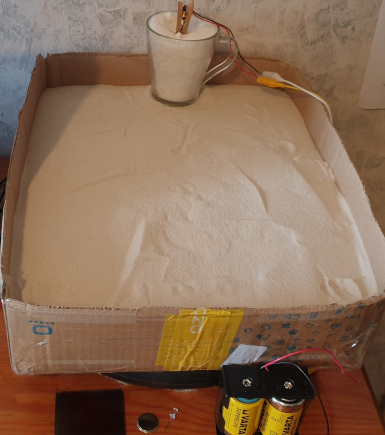
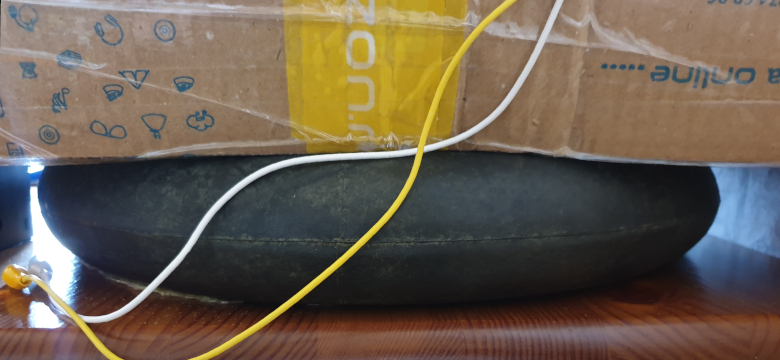
There are other configurations that can be read about in literature and on specialized sites (see the list of sources in a previous article), most of them are based on the principle of isolation from vibrations coming from the floor (camera) and absorption of intrinsic vibrations of the elements of the optical scheme (sand). This design is one of the simplest ones suitable for a small working area. On a stable table located away from windows, heating systems and other drafts, and creating objects that vibrate, a lightly inflated rubber chamber from a small wheel (about 30 cm in diameter) is placed, on it is a box (I have a cardboard, but better from something denser) in which 10-15 kg of pure dry fine quartz sand is poured (for example, for aquariums). The optical scheme is assembled directly on the surface of the sand, with the help of sand it is also convenient to fix the elements of the scheme by digging it. It is important that the sand is dry and does not stick to what will be installed on it, It is also important to ensure that sand does not get into the optics, quartz easily scratches the glass. A laser, if it is of low power (<5 mW), can be fixed in a clothespin, which can be stuck in a glass with the same sand.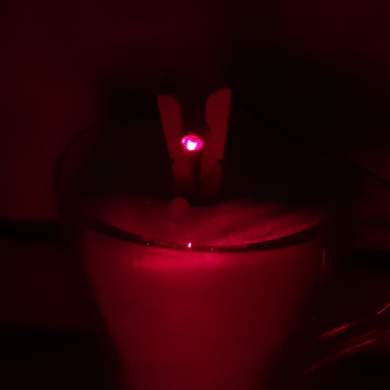
- The laser module used was a laser module purchased on Aliexpress with a declared power of 5 mW, a wavelength of 650 nm and power from 3 V (search query “4mm laser module 650nm 5mw”), there may be strong differences between the modules from copy to copy, so it’s worth buying several different laser modules and choose from them those that will show the longest coherence length and stability at maximum power (see previous article) You need to choose modules with the most massive case, with active elements on the board and a laser case diode, ideally if there is a variable resistor on the board for accurate current setting. Power must be supplied from capacious batteries or accumulators that can power the laser for several hours without noticeable voltage drop. A lens is removed from the module itself to produce a diverging beam.
- A laser radiation power meter is also needed, which will be needed to calculate the optimal exposure and to control the uniformity of lighting, which should not differ by more than 30% in the center and on the periphery of the photo material. In the simplest case, you can use a large-area silicon photodiode with a microammeter, for example, FD-7k, or a photodiode with a built-in amplifier like OPT101 and a voltmeter. For them, you can find graphs by which you can determine the illumination and conversion factors for different wavelengths. But it is better to purchase a special calibrated power meter for lasers, for example, Coherent Laser Check (more expensive and rare), Sanwa LP1 (cheaper and widespread).
- You also need to take care of non-actinic lighting (which will not noticeably affect undeveloped photo material), fortunately, the sensitivity of holographic photo materials is much lower than that of classic photo materials, so a small amount of light from a street lamp falling through the curtains on the windows is not particularly it will hurt, and during the chemical treatment procedure it is quite possible to do with such gloomy lighting. But when installing a photographic plate and other related circuit elements, it is good to have a sufficient level of illumination, the blue LED from the Litiholo set is not suitable, the PFG-03M have noticeable sensitivity in the blue area, you need green lighting, the closer to 500 nm, the better. You can choose the appropriate LED, it will be even better than the recommended lamp with a light filter recommended in some sources, the brightness of the lighting must be provided the minimum necessary, when the lighting does not need to be better off. I used a “smart” LED lamp, choosing the most suitable shade and setting the minimum brightness.
- Silver halide photographic materials, as mentioned above, require chemical treatment. During which the latent image formed during exposure (silver halide crystals, irradiated with light, on which points of free metallic silver appeared) is amplified many times and an already visible image is obtained, since the developer mainly restores halide crystals with such metallic to metallic silver dots. For PFG-03M, the manufacturer recommends the so-called. physical developer GP-3 . You can also try another physical developer that contains less caustic and toxic compounds and does not emit ammonia. OD-1. Physical developers, unlike the chemical ones used in classical photography, form completely different particles of metallic silver in character and shape, which are necessary for the formation of an interference pattern, and the holograms themselves are so-called. amplitude-phase. Physical developers contain special components that dissolve the unexposed granules of silver halides, followed by the deposition of silver metal on the exported, i.e. almost all of the silver from the photographic material remains in it, and spherical silver particles are formed - reflecting light, and not filiform - absorbing. An alternative recommended by some authors and rejected by others (I recall that we are talking only about PFG-03M) is a process of manifestation by chemical developers with subsequent bleaching, these are JD-4 and SM-6 + PBU-Amidol kits. Due to the bleaching process, metallic silver is converted back to silver halide crystals having a refractive index different from gelatin, so-called phase holograms with theoretically significantly greater diffraction efficiency, and hence brightness. However, PFG-03M photographic plates are not intended for bleaching, they have relatively little silver (1.6 g / m2 , whereas for PFG-01 bleaches 3.3 g / m 2 ), and the holograms obtained after bleaching should not be noticeably brighter. I used GP-3 developer recommended by the manufacturer from a ready-made set of chemical compounds.
For its manufacture (for 1 liter of solution) you will need:
0.2 g of methylphenidone ;
5 g of hydroquinone ;
100 g of anhydrous sodium sulfite (not to be confused with sulfide d om!);
25 g of sodium hydroxide (caustic soda, caustic soda);
45 g of ammonium thiocyanate (ammonium thiocyanate).
Reagents can be purchased at many chemical reagent stores, or in the same place as photographic plates. If the solution will not be made from a ready-made set, then in addition to distilled water and some dishes, scales will also be needed, for this, common Chinese jewelry scales are well suited to an accuracy of 0.01 g.
To prepare the solution, you will need two chemical glasses (or something similar, there is a lot of space for imagination), pour about 400 ml of water into each (you can not measure the water with measuring cups, just weigh it, it will be even more accurate), distilled water must be used; it is sold in car dealerships. It is also worth putting on safety glasses and gloves, all utensils should be glass, and the spoon for mixing glass or plastic. Slowly add sodium hydroxide into the first glass with vigorous stirring, the solution heats up noticeably, then methylphenidone. In the second glass, first we dissolve about 10 g of sodium sulfite, and then all the hydroquinone, after dissolving we add the remaining sodium sulfite, and after it all the ammonium thiocyanate. After dissolving ammonium thiocyanate, the solutions are poured together and the volume is adjusted to 1 liter with water. Then we filter the solution through a piece of cotton wool, placed in a funnel, and let it stand for 2 hours. The resulting developer must be stored in the refrigerator, it is suitable for use until it turns yellow (a month or more). It is very important to observe this recipe, otherwise the precipitate may precipitate and the developer will be spoiled.
The resulting solution is a concentrate, and a working solution is prepared immediately before use in a ratio of 15 ml of concentrate and 400 ml of water. Therefore, if you do not plan to produce many holograms at once, you can divide the amounts of all reagents into two and prepare 500 ml of the main solution, from which you can get up to 13 l of the working solution of the developer.
In case of non-use of the bleaching procedure after development, it is recommended to carry out a fixing procedure, during which the silver halide granules remaining in the emulsion will be removed. Any thiosulfate photographic fixer (fixer) is suitable for this, for example, just 150 g of sodium thiosulfate crystalline hydrate(sodium hyposulfite, sodium sulfate) per 1 liter of distilled water, after mixing, let the solution stand for 2 hours. In the presence of sediment, turbidity or flakes, the resulting solution can be periodically filtered through a piece of cotton wool inserted into the funnel and stored at room temperature for a long time, the used solution can be returned back to the tank to the rest, it is depleted extremely slowly. - So, the reagents are prepared, you still need the baths for chemical treatment, sucks from the supermarket are suitable for this. Naturally, all utensils in contact with chemicals should not be used for food or drink.
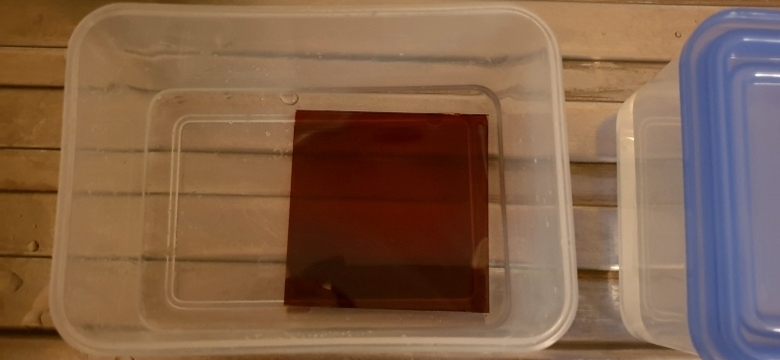
The next step will be the assembly of the optical scheme :
For transmitting holograms: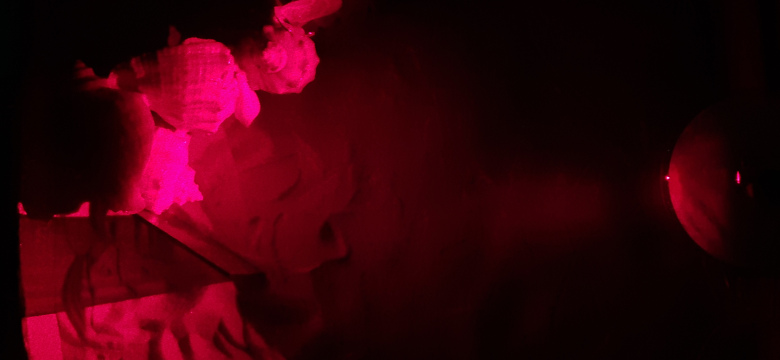
For reflective holograms: The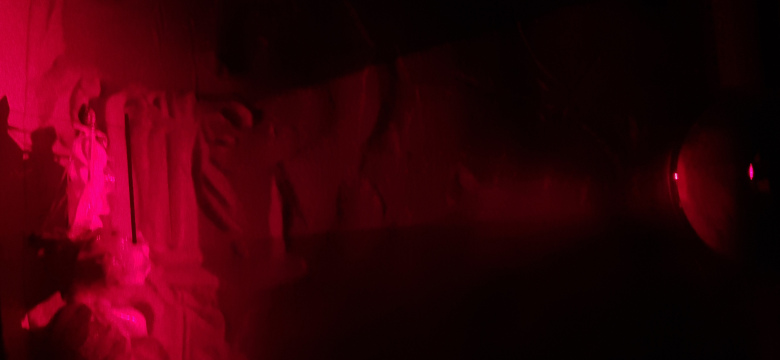
laser beam should incident on the photographic plate at an angle close to the Brewster anglefor this type of material, for glass it is about 56 °, in practice, for the convenience of lighting, this angle is made approximately equal to 45 °. This is done to minimize internal reflections in the photographic plate, which can spoil the image, causing strips similar to a cut of wood, while the light beam itself must be polarized and correctly oriented, the correct orientation can be determined by rotating the laser around its axis and observing the reflection from the glass, minimal reflection is needed. It is also absolutely necessary to close the ends of the photographic plate onto which the laser light enters with an opaque material, otherwise the image will have defects in the form of horizontal stripes, as in the photo below.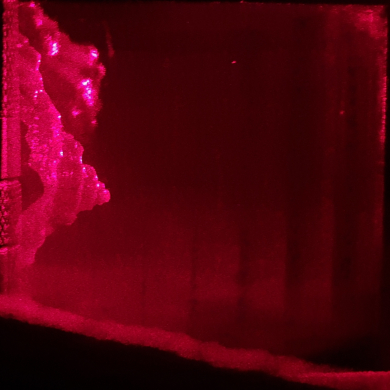
Next, you need to determine the optimal exposure time, for this you will have to use several photographic plates. To begin with, for the selected circuit, we determine the illumination on the surface of the photographic plate, installing the photosensitive element in place of the plate, and any lighting should be turned off. For this I used Sanwa LP1 with a diameter of the sensor 0.9 cm, the power was 39.9 μW (you must not forget about the correction factors depending on the wavelength). Area of a circle is calculated by the formula π * d 2 /4, which will be 3.14 * 0.92 / 4 = 0.64 cm 2 , and illumination is respectively equal to 39.9 / 62.3 = 0.64 mW / cm 2 . Having adopted the sensitivity of PFG-03M 500 μJ / cm2, the required exposure will be 500 / 62.3 = 8 s. The real optimal exposure must be found experimentally, for this it is necessary to make several holograms with different exposures, starting from the theoretical one, for example 5, 10, 15, 20 s, when finding the brightest region, you can conduct a cycle with less discreteness, for example, as early as 1 s. It is also important to remember that inadequate exposure affects image brightness to a much lesser extent than excessive exposure. To determine the optimal exposure, it is not necessary to use one plate for each time period, they can be cut or just cut off the light beam from the laser with an opaque material and gradually open it, the main thing is not to touch the optical table and circuit elements. I got the brightest holograms at an exposure of 15 s,2 .
The sensitivity may vary from batch to batch and vary markedly during storage, so this procedure must be carried out for all new photographic materials and after several months of storage. And the exposure time should be counted with any change in the optical scheme.
Next, the exposure is carried out similarly with photopolymer plates, we collect the optical scheme, heat up the laser, block the beam, install the photo plate (with an emulsion for objects), turn off the lighting, give stabilization time, perform exposure for the right time, close the beam again, and send the plate to the chemical processing. To determine which side of the plate the emulsion is on, you need to breathe on it, the side with the emulsion does not fog up, but touching the emulsion is strictly prohibited, it is slightly sagged (very soft) and will be irretrievably damaged by touching. This is one of the reasons why it is better to work with gloves, other reasons are the use of toxic and corrosive chemical solutions and the sharp edges of photographic plates. Further work is better in the dark, or in low green light,
The exposed photographic plate is lowered into the developer solution with the emulsion side up, the height of the solution above the plate should be at least 1 cm, the temperature of the solution is 19-21 ° C, the processing time for GP-3 is 10 minutes, sometimes a bath should be shaken during development to uniformly pass the process . According to other recommendations, the manifestation time is 5-8 minutes. at 17-18 ° C, here you need to experiment and select the optimal time for a specific temperature, copies of the plates, recording schemes to obtain the most vivid holograms. By the way, everything turns out, although it is clearly not optimal at 25 ° C, you should not raise the temperature above, there is already a risk of damaging or even washing off the emulsion layer, in summer the solutions may need to be cooled. Then the plate is washed with running water for at least a minute and placed in a fixative solution, only then can the ordinary bright white lighting be turned on. The spent developer is poured, it can not be reused. The plate should acquire a light brown color, initially slightly colored and bluish. If the color of the plate is yellow, then either the exposure is too small, or you need to increase the development time. If the color of the plate is black, then either the exposure is too long, or it is necessary to reduce the development time (or lower the temperature of the solution), or the plates are damaged. It is enough to fix it for 3 minutes, then another rinse with cool running water for 5-10 minutes, after which the plate should be rinsed with distilled water. The main processing is over, but the image will still not be visible, due to the swelling of the emulsion it is in the infrared region, the hologram needs to be dried. This can be done slowly, for which, before drying, the hologram is immersed in a weak aqueous solution of detergent, ideally a special wetting agent for photography, such as Kodak Photo-Flo, and mounted on the edge on a paper towel until it dries completely. It is extremely important that the runoff of water and the drying process take place uniformly, otherwise the appearance of spots on the image is inevitable. A quick way is to use alcohol, in the case of ethyl alcohol, you can use immediately 96% rectified, and successively 50%, 80% and 96% solutions, in order to save ethyl alcohol. In each solution, you need to withstand the hologram for a minute, constantly shaking the bath. After a 96% solution, the plate is similarly placed on the edge on an absorbent surface and remains there until it dries completely, after some time, a visible image will begin to appear for reflective holograms. Then the surface from the side of the emulsion is painted over with black spray paint or sealed with a matte black film, the hologram is ready.
There is also information that it is possible to dry in 50% isopropyl alcohol , I used ethyl alcohol myself, but I can say that pure isopropyl alcohol irreversibly spoils the hologram without image, the image appears only in places where on the surface of the hologram at the time of immersion there was water in alcohol.
Here are a few photos of the resulting holograms:
Reflective holograms.
Three angles of one not very deep hologram, but still it’s rather difficult to focus the camera.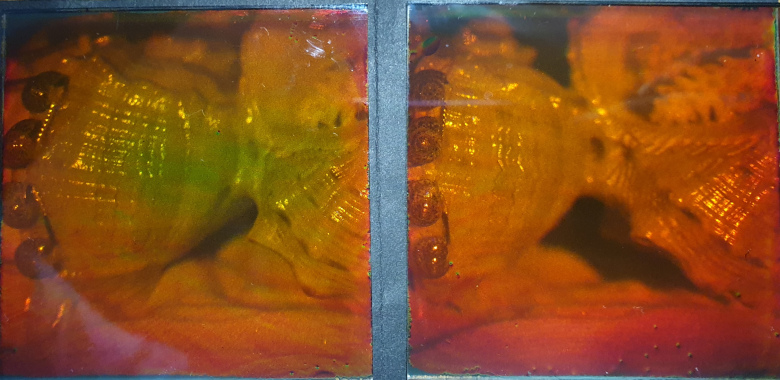
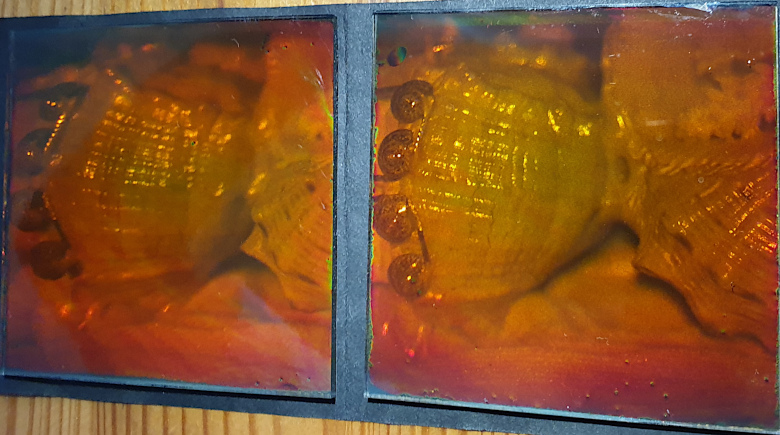

And this photo is clickable. Sand and sun. Skipping holograms. The first angle. In reality, the image has sharpness over the entire depth, you can see the limitation of classical photography and a good laser coherence length.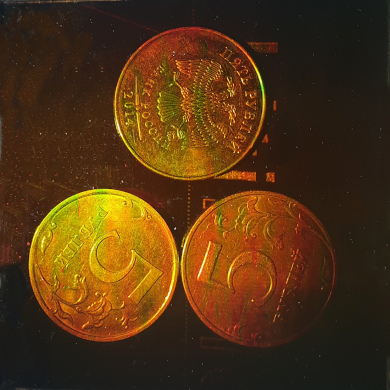
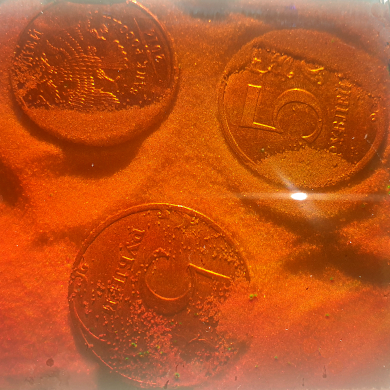

The second view of the same object.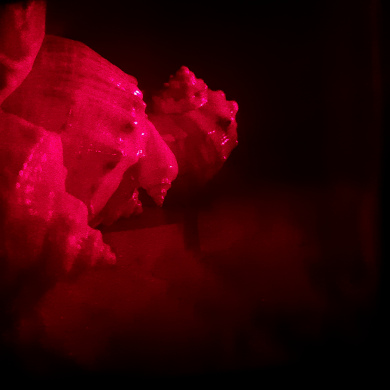
As it turns out in practice, everything is not so complicated and scary as some sources describe, and holographic materials are quite difficult to lighten (ruin by exposure to light), and the exposure time can vary over a wide range, and it is not necessary to withstand the temperature with an accuracy of 0.5 ° C, and you can get rid of the vibrations in a high-rise building in a metropolis, and a suitable laser can be chosen from cheap ones. In general, at least some image cannot be obtained, it is only possible without completely ensuring proper vibration resistance or by violating at times other recording and processing parameters. But in order to obtain the most vivid holograms, it is nevertheless necessary to select the optimal parameters of all processes, and then strictly observe them, and control the temperature and measure time with high accuracy. T. about.
As usual, any questions, suggestions and comments are welcome!
Only registered users can participate in the survey. Please come in.
Do you want to do amateur or professional holography in the foreseeable future?
- 34.8% Yes 30
- 59.3% No 51
- 5.8% Have or have been in the past 5
